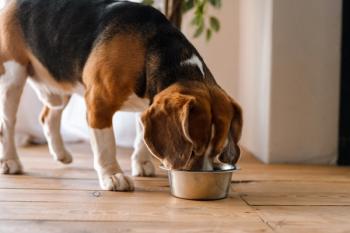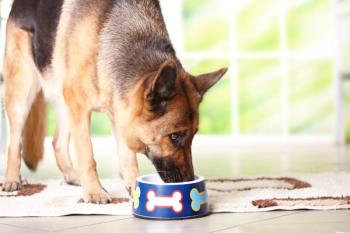
Nutritional and medical management of canine urolithiasis, Part 1 (Proceedings)
The purpose of the lecture is to provide an overview and an update on therapeutic options available for the four most common mineral types of uroliths in dogs.
During the past three decades, a tremendous amount of information has been generated regarding the etiology, detection, treatment, and prevention of canine urolithiasis. No longer is surgical removal the only option available when dogs develop urolithiasis, nor is surgical removal the "treatment" of choice" in all patients. Although we know a lot more information about urolithiasis in dogs than we did three decades ago, there is still a lot that we don't know and remains to be discovered. Nonetheless, our ability to medically manage this disease in dogs has dramatically improved since 1973, and new knowledge continues to be generated. The purpose of the lecture is to provide an overview and an update on therapeutic options available for the four most common mineral types of uroliths in dogs.
Canine urolithiasis overview table
Distribution of mineral types of canine urolths
In 2003, the distribution of canine uroliths (n = 28,629) submitted to the Minnesota Urolith Center (courtesy of Dr. Carl Osborne and The Minnesota Urolith Center) were as follows:
- struvite = 41%
- calcium phosphate = 0.5%
- calcium oxalate = 40%
- silica = 0.3%
- cystine = 1%
- mixed composition = 11%
- purines (ammonium urate, sodium urate, uric acid xanthine) = 6%
Since 1981, the prevalence of calcium oxalate in dogs has continued to increase, and it is equal to that of struvite now. Successful long-term management of urolithiasis is dependent upon an understanding of each mineral type.
Calcium oxalate urolithiasis
Background information
- The majority of dogs diagnosed with calcium oxalate urolithiasis are not hypercalcemic
- Proposed reasons for why some normocalcemic dogs develop calcium oxalate uroliths are
o Excessive GI absorption of calcium (intestinal hyperabsorption of calcium)
o Excessive renal loss of calcium
o Defective nephrocalcin, a glycoprotein that inhibits calcium oxalate crystal growth
Medical dissolution protocol
- Currently, calcium oxalate uroliths in dog can not be medically dissolved.
- Therapeutic options available
o If stones are detected when they are small enough, they may be able to be removed via a urinary catheter or by voiding urohydropropulsion (Lulich JP. VCNA Small Anim Prac 29:283-292, 1999)
o If stones are too large to be removed non-surgically, and the dog is symptomatic, it may be necessary to initially remove all the stones surgically, and then take appropriate dietary and monitoring steps to detect recurrence of stones when they are small enough to remove non-surgically (i.e. via urinary catheter or voiding urohydropropulsion).
Prevention of recurrence
- Recurrence of calcium oxalate uroliths in dogs is common
o In 1992, Lulich published an abstract (JVIM) that revealed that recurrence rates of calcium oxalate uroliths in dogs 12 months after surgery was 36%, after 24 months was 42%; and after 36 months was 48%
- Despite high recurrence rate, the following steps can be taken to reduce the likelihood of having to perform repeated cystotomies
o Diet should have the following characteristics: protein-restricted; alkalinizing, low in oxalate; not calcium-restricted, sodium-restricted; and canned if client can afford.
- One diet that meets these criteria is Hill's Prescription Diet u/d. this diet is protein-restricted, however the amount of protein in this diet is high .enough that it can be used long-term
- Hill's Prescription Diet u/d and Waltham S/O Lower Urinary Support are both high in fat
- Same precautions and contraindications (pancreatitis and hyperlipidemia) mentioned for Hill's Prescription Diet s/d should be taken when feeding these diets.
Hill's prescription diet w/d*
- Can be used in patients where a high-fat diet is contraindicated
- This diet is an acidifying diet, and therefore should be used in combination with potassium citrate, which is primarily used for its alkalinizing properties.
Recheck protocol
Although calcium oxalate uroliths can not be dissolved medically, additional surgeries in dogs can be avoided by diligent monitoring with the goal of detecting a recurrence when tones are small enough to remove by urinary catheter or by voiding urohydropropulsion.
- The following frequency of rechecks is recommended:
o q 2 months for 1 year; if no recurrence, then
o q 4 months for an additional year; if no recurrence, then
o q 6 months thereafter.
- At each recheck, evaluate a lateral abdominal radiograph and a urinalysis.
- If at any time the dog has a recurrence, perform voiding urohydropropulsion and then go back to the beginning of the recheck protocol
Cystine urolithiasis
Background Information
- Cystine is an amino acid with low solubility in urine
- Cystinuria is a renal tubular disease characterized by impaired renal reabsorption of cystine
- Cystinuria is a hereditary disease. Mode of inheritance in Newfoundlands is autosomal recessive.
Medical dissolution protocol
- Dietary Intervention
o Hill's Prescription Diet u/d is the diet of choice (please see previous two sections for contraindications)
o Supplement with carnitine (50 mg/kg PO BID) because ~60% of cystinuric dogs lose excessive of carnitine through their kidneys.
- Drug Intervention
o Thiola (2-MPG, Tiopronin) is the drug of choice for dissolution
- mean dissolution time = 78 days
- thiola is an expensive drug
- should monitor for side effects (dermatologic—rashes, ecchymosis; hematologic abnormalities; liver disease)
- Recheck Protocol
o During dissolution period, recheck the following at monthly intervals (survey lateral radiograph if stones dense, otherwise lateral double contrast cystogram [possibly substitute U/S], CBC, Profile (hepatic),UA)
Prevention of recurrence
- Like urate urolithiasis in dalmatians, cystine urolithiasis tends to become easier to manage the older the dog becomes.
- Diet - Hill's Prescription Diet u/d and supplement with carnitine (50 mg/kg PO BID)
- Drug - low dose thiola may be necessary in some dogs with cystinuria during their acute active phase.
o Dogs on long-term low dose thiola should have a CBC and Serum Chemistry Profile monitored q 2-4 months.
Since this is a hereditary disease, owners should be strongly encouraged not to use these dogs for breeding.
Newsletter
From exam room tips to practice management insights, get trusted veterinary news delivered straight to your inbox—subscribe to dvm360.



